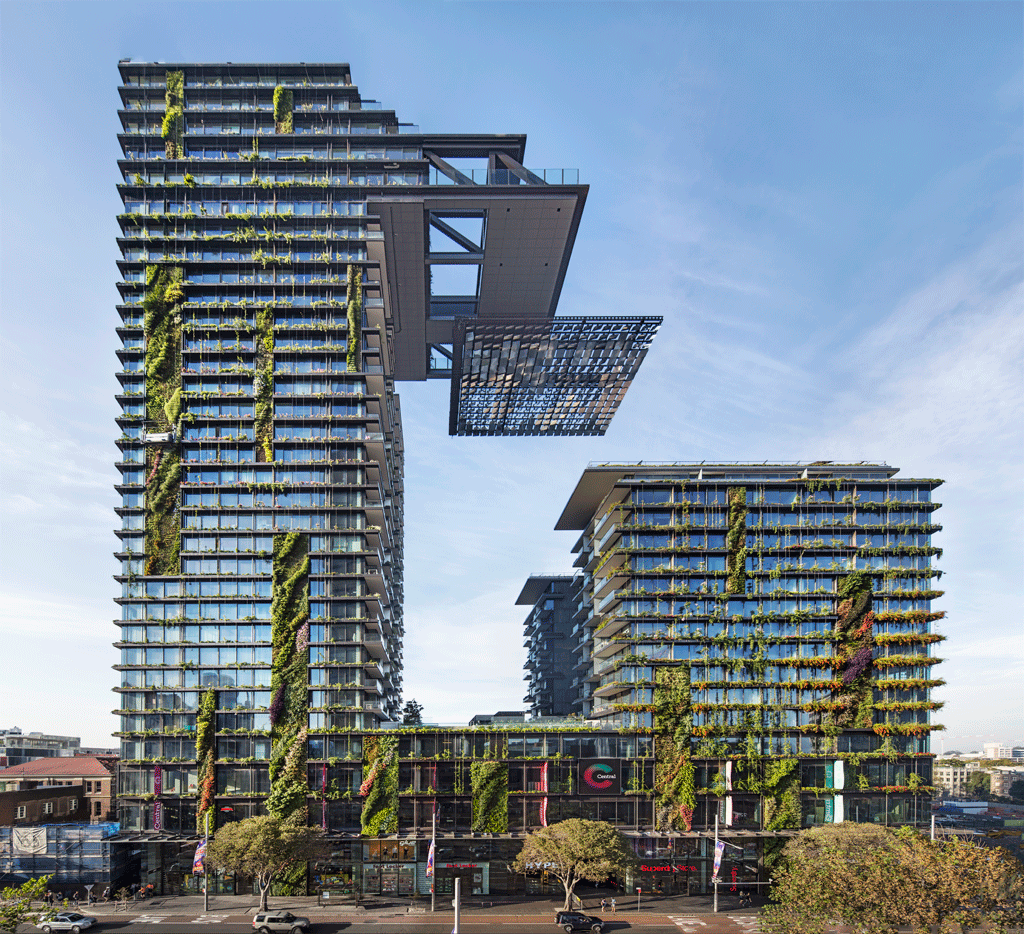One Central Park à Sydney
One Central Park de Jean Nouvel à Sydney a quelque chose d’un autre monde. Sans doute est-ce dû à la végétation qui grimpe le long des façades, à l’extravagante plate-forme en porte-à-faux qui semble attendre l’arrivée d’un vaisseau spatial ou encore à la surface créée par les reflets des lumières et les effets de miroir. En fait, le bâtiment fait partie d’un écosystème émergeant composé d’intrigantes réalisations comprenant notamment, à quelques blocs de là, l’ondulant bâtiment de briques signé Frank Gehry pour l’Université technologique de Sydney (UTS) ainsi que la Good Line, version australienne de la High Line New-Yorkaise, laquelle commence doucement à raccorder cet ancien quartier industriel au port de Darling, un peu plus au nord.
La tour de 166 mètres imaginée par Jean Nouvel domine aujourd’hui le quartier de Central Station. Son mur végétal, conçu par son fidèle collaborateur Patrick Blanc, est le plus haut du monde. À sa base, la tour se fond parfaitement dans le paysage urbain, ses espaces vitrés abritant de nombreuses boutiques sans identité donnent sur un centre commercial dont le verre facetté fait écho au bâtiment One New Change du même architecte à Londres. Au cœur du complexe, une nouvelle place urbaine est à la fois raffinée et populaire sans pour autant sortir de l’ordinaire. L’architecture, semble-t-il, est réservée à la tour et son étrange porte-à-faux conçu comme un mécanisme servant à refléter la lumière naturelle au sein du jardin arboré. Peu efficace, ce porte-à-faux est avant tout un signe urbain, un repère. Plus qu’amener la lumière au sein de l’espace vert, l’avancée est devenue remarquable pour le jeu de lumière qu’elle offre une fois la nuit tombée, à la façon des jeux de lumière de Hong Kong, et qui nous rappelle le penchant Debordien de Jean Nouvel. One Central Park tient finalement davantage de la salle de spectacle que d’une discrète tour résidentielle, et tant mieux pour elle. •

One Central Park vue depuis Broadway.
Texte original en anglais
There’s something other-worldly about Jean Nouvel’s One Central Park. The green creeping up the façades, the extravagant cantilevered platform which looks like it’s waiting for a spaceship to land, the barrage of reflecting lights and mirrors. In fact it’s a part of an emerging ecosystem of intriguing architecture with Frank Gehry’s undulating Dr Chau Chak Wing brick building for UTS a couple of blocks away as well as the Goods Line, Sydney’s version of New York’s High Line slowly starting to connect this former industrial quarter to Darling Harbour.
Nouvel’s 166-meters-tall tower now dominates the district around the city’s Central Station. Its green wall, designed by his long-time collaborator, Patrick Blanc, is the world’s tallest. At its base the tower segues seamlessly into the cityscape, its glass-fronted stores creating plenty of generic retail which then opens up to a mall with a few faceted glass that echoes of the architect’s One New Change in London. At the heart of the complex a new urban garden square is fine and popular but unremarkable. The architecture, it seems, is confined to the tower with its odd cantilever conceived as a mechanism for reflecting sunlight back down into a raised garden space. It is marginally effective but its real purpose is as a sign, an identifier. Rather than reflecting light onto the communal green space it has become remarkable for its nightly light-show, a Hong Kong style spectacular which reminds us of Nouvel’s Debordian adherence to an architecture of spectacle. It is more epic nightclub than discreet residential tower, and far better for it. •
—
Photo de Murray Fredericks, courtesy Frasers Property Australia et Sekisui House Australia.
Texte écrit par Edwin Heathcote.

